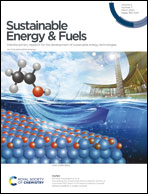A hollow neuronal carbon skeleton with ultrahigh pyridinic N content as a self-supporting potassium-ion battery anode†
Abstract
Safe, non-toxic and low cost carbonaceous materials, as ideal anodes for potassium ion batteries (KIBs), have broad application foregrounds. However, due to the large radius of K+, the challenges of cycling stability and structural stability of electrode materials are severe. In this paper, a flexible carbon sheet with ultrahigh pyridinic N content and a three-dimensional skeletal structure is reported as a self-supporting anode for KIBs and named HNCS. Herein, the hollow interconnected structure, being similar to a neuronal cell network, can effectively relieve the stress of volume expansion during cycling and provide more potassium storage space. In particular, the content of pyridinic N reaches up to 16.3% in HNCS (the N doping ratios in overall material is 31.7% and the pyridinic N ratios in N content is 57.4%) and is higher than most previous reports about N-doped carbonaceous materials. HNCS as a self-supporting anode shows great electrochemical performance, especially in terms of the superior cycling stability. HNCS delivers an initial charge capacity of 219.3 mA h g−1 at 100 mA g−1 and maintains 90% after 200 cycles and still displays a reversible capacity of 134 mA h g−1 after 500 cycles at 0.5 A g−1. Besides, the contribution of surface-dominated K-storage is quantitatively analyzed by CV measurements.



 Please wait while we load your content...
Please wait while we load your content...